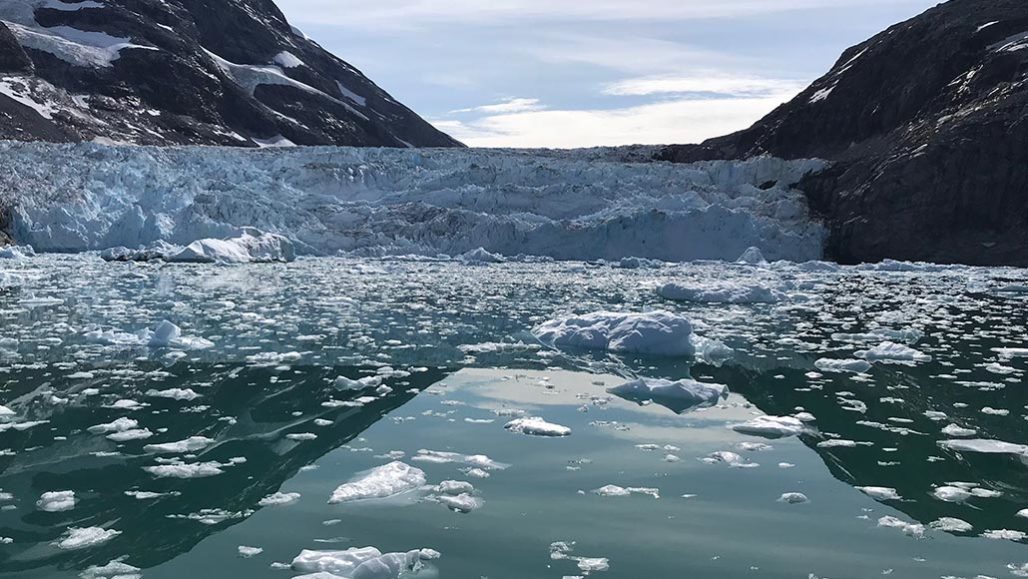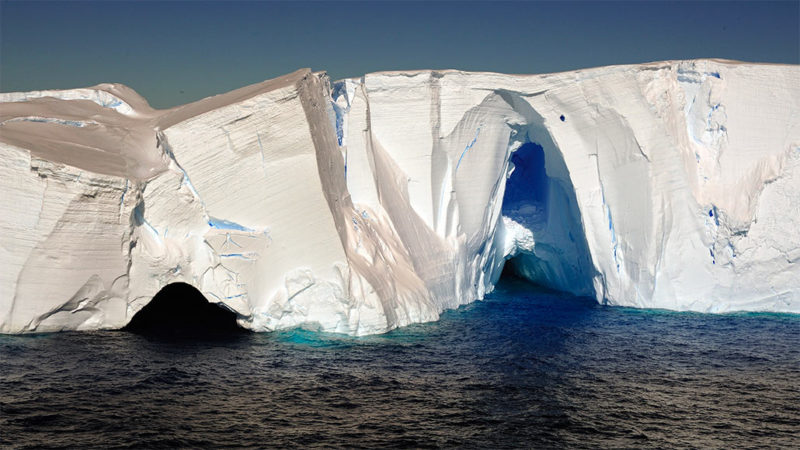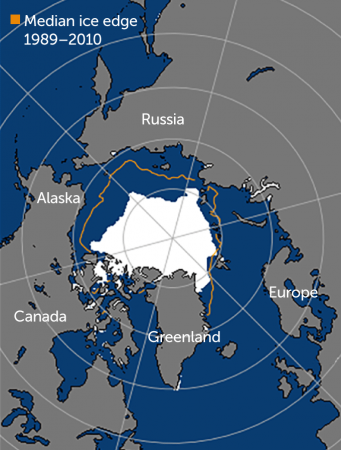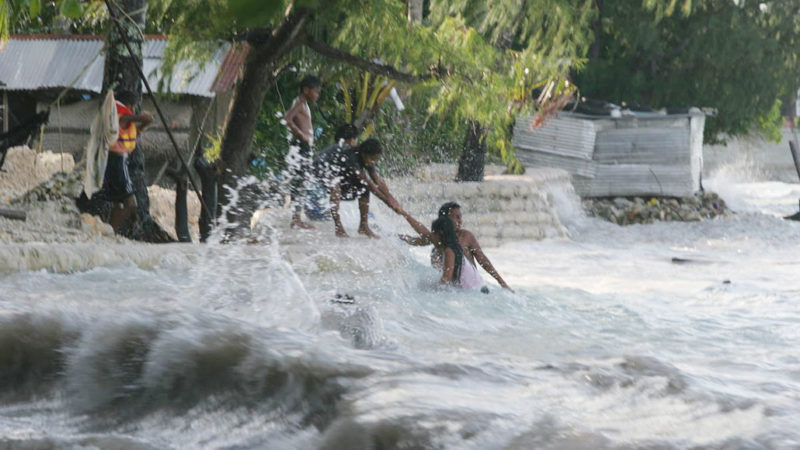Report sums up climate’s already dramatic impact on oceans and ice
And it warns of worse to come, even if emissions of greenhouse gases start to fall

Climate change creates a whole world of problems, from melting glaciers (a tidewater glacier in southeast Greenland in the summer of 2018 shown) to the ocean floor. It’s probably only going to get worse, according to a new report.
IMAGE COURTESY OF ERIC RIGNOT
Earth’s polar caps quickly losing ice. Coral reefs bleaching to a chalky white. Stronger storms devastating islands and cities, claiming lives and destroying homes. Those aren’t claims of what our world faces in a warmer future. Those climate change impacts are already happening — and due to worsen. That’s the finding of a new report from the United Nations Intergovernmental Panel on Climate Change, or IPCC.
The United Nations issued a summary of the new assessment on September 25. It’s the panel’s first comprehensive update on how human-driven climate change is upsetting not only Earth’s oceans, but also its frozen regions, or cryosphere. Just how severe things get will depend on whether most countries lower their releases of climate-warming greenhouse gases — or just continue pumping large quantities of them into the air.
The report focuses on two potential scenarios. One involves cutting greenhouse gases enough to limit global warming to around 2 degrees Celsius (3.6 degrees Fahrenheit) above preindustrial levels. By the way, the world is already more than halfway there; global temps have warmed by 1.1 degrees C (2 degrees F) since 1900, according to a second new report. Prepared by the World Meteorological Organization, it was released September 22. In a second scenario, pollution continues at its current pace to where Earth eventually warms some 4 degrees C (7.2 degrees F).
Science News for Students took a look at the report’s predictions. They offer a scary view of potential changes that would impact societies and our natural world. They’re based on the latest available science.

Glaciers and ice sheets
Already, glaciers and ice sheets are shrinking. Some are disappearing super fast. The Greenland ice sheet lost an average 278 billion tons of ice per year from 2006 to 2015. That amount of water alone is enough to cause average global sea levels to rise about 7.7 millimeters (0.3 inch) a decade.
More dramatically, on July 31 a record-breaking 57 percent of that ice sheet showed signs of melting. Meanwhile, the Antarctic ice sheet has been losing an average 155 billion tons per year.
Glaciers from the Himalayas to Chile and Canada have seen big melts. Together, they’re losing another 220 billion tons of ice per year. Melt water from these glaciers today slakes the thirst of millions of people and their crops. If those glaciers disappear — and many are starting to — their downstream communities could become very thirsty.
Sea ice
Patches of thick ice has for millennia blanketed the Arctic Sea. Each winter the extent of that blanket expands and thickens. In summer, it shrinks and thins. The large expanse of white ice, here, plays an important role in reflecting sunlight away from Earth. This has kept the Arctic from getting too hot.

But that ice is shrinking. Its overall mass has been steadily falling for the last 40 years, the IPCC says. All that melting means that little ice now survives in place for at least five years. And that’s important. Such hardened ice tends to be sturdier than single-season ice. In fact, the fraction of sea ice older than five years is only about 10 percent of what it was 40 years ago, the report says.
Satellite records show that the lid of sea ice covering the Arctic Ocean is not just thinning. It’s also covering less water in summer. The 2019 summer minimum, reached September 18, is tied with two other years for the second lowest amount: 4.15 million square kilometers (1.6 million square miles).
The IPCC analysis predicts that if global warming can be limited to 1.5 degrees C (2.7 degrees F), the probability of September being ice free after the summertime melt is a mere 1 percent. But at 2 degree C (3.6 degrees F) warming, that risk jumps to between 10 and 35 percent. Arctic mammals, including polar bears, and birds depend on that ice.
And less ice also means more exposed water, which is dark. That dark water will absorb more sunlight and heat, intensifying feverish temperatures in polar regions.
Permafrost no more?
Permanently frozen soil, also known as permafrost, is undergoing a surprising warming across the globe. This carbon-rich soil has been warming an average of 0.29 degree C (0.52 degree F) from 2007 to 2016, the IPCC notes. This ground is estimated to contain almost twice as much carbon dioxide as is in the atmosphere. It also contains methane, another greenhouse gas. So if permafrost thaws, it could spew extra climate-warming gases into the air. To date, it’s not clear if much of that is happening yet.
But thaw it will, the IPCC report says. By 2100, the expanse of Earth’s permafrost could decrease by one quarter if greenhouse-gas emissions are lowered. And if things don’t change, more than two-thirds of that permafrost could thaw. It would exhale tens to hundreds of billions of tons of carbon, in the form of CO2 and methane, into the atmosphere by 2100. Thawed regions might see more plant growth. If that happens, those plants would pull some of that carbon back into the soil — but not nearly enough to make up for all the carbon being released by the thawing.
Ocean warming
So far, oceans have swallowed up more than 90 percent of the climate’s excess heat. This has warmed them. Marine heat waves are getting more severe and lasting longer than they did decades ago. Such events can scorch coral reefs and help boost the frequency of toxic algal blooms. And human-caused climate change may have been responsible for nearly 90 percent of these events between 2006 and 2015, the IPCC says.
Those hot waters will get even hotter under any emissions scenario. Such an oceanic warming is already driving many ocean-dwelling animals to move toward cooler digs near the poles. But in new environments, migrant animals can interfere with local food webs. Climate-driven shifts in ocean species may have already begun shrinking the populations of food fish.
If greenhouse-gas emissions don’t drop dramatically, by 2100 ocean surfaces may be absorbing five to seven times more heat than they did in 1970. And heat waves would be 50 times more common than in 1900. But even in a low-emissions scenario, heat waves be more frequent by the end of the century — 20 times more frequent in 1900.
Ocean acidification
It’s not just heat that oceans absorb. Since the 1980s, the world’s biggest water bodies also have been taking in an estimated 20 to 30 percent of the excess carbon dioxide in the atmosphere. One result: The seas are becoming more acidic.
That’s going to continue, the IPCC report says. In a high-emissions scenario, the pH of the ocean surface is expected to drop by around 0.3 pH points (on a scale of 14) by the end of the century. That acidity may make it more difficult for creatures like snails, crabs and shrimps to build their shells. It also will harm the function of tiny algae that ferry carbon to the deep ocean. Acidity also depletes seawater of the minerals that corals use to build their exoskeletons.

Sea level rise
Sea levels are rising faster with time. And that swell is going to continue under any emissions scenario, the IPCC says. From 2006 to 2015, sea level rose some 2.5 times as fast as it did between 1901 to 1990. Melting ice sheets and glaciers are primarily to blame.
With higher sea levels come greater flooding and coastal erosion. Encroaching seawater can also shrink habitats and force species along coastlines to relocate — if they can. Nearly half of coastal wetlands already have disappeared over the last century, due partly to higher seawater.
Extreme events related to high seas that were once rare — happening once a century. In many places by 2050, especially in the tropics, such extreme flooding could happen at least once a year. That puts coastal areas and small islands in even greater danger.
Extreme weather
Human-driven climate change has likely increased the amount of wind and rain associated with some hurricanes already. These storms will probably get more intense. They may bring bigger storm surges and record rains, even if emissions fall.
What could become more frequent, and possibly less predictable, are extreme El Niño and La Niña events. These are planet-wide swings in weather driven by water-temperature patterns in the Pacific Ocean. Extreme El Niños may hit twice as often in this century than in the last, the report says. These weather disturbances are also expected to become more hazardous, causing dryer droughts and more torrential downpours around the world.







